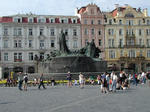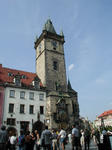
The oldest and
most important square in historic Prague dating from from the 12
th cent. Its dominant feature is the Old Town Hall (prob. 1299) with its tower, oriel chapel (2
nd half 14
th cent.) and the Astronomical Clock (bef. 1410). Church of Our Lady before Tyn (Gothic, 14-15
th cent.), Tyn School (Gothic and Renaissance), House at the Stone Bell (Gothic), Golz-Kinsky Palace (Rococo), church of St. Nicholas (Baroque, K.I. Dientzenhofer), House At the Minute (Renaissance), Jan Hus monument (L. Saloun, 1915).
The Old Town is the very centre of Prague.
Many of the museums, markets, shops, restaurants and pubs are located in this area. Merchants and craftsmen began to settle here from the tenth century, but the citizens granted town status in 1338. Il cuore della Cittŕ Vecchia rappresenta la Piazza della Cittŕ Vecchia che č la piazza piů spettacolare ed antica di Praga. The square is surrounded by colourful houses of Romanesque or Gothic origin with fascinating house signs. One of the most striking buildings is the Old Town Hall, famous for its
Astronomical Clock (Orloj), built in 1410.
Every hour a crowd of spectators watch a mechanical performance by 12 Apostoles.
The first stone houses grew up around the then busy market, free burghers built the first Prague town hall here, and here Charles IV. laid the basis for the impressive Church of 0ur Lady Before Tyn, executions and celebrations took place here, one of the last bombs of World War II. fell here. The coronation processions passed through here along the so called Royal Way, leading from the nearby
Powder Tower, where the second royal palace stood on the site of the present secessionist Municipal House, around the Karolinum University across Charles Bridge to Prague Castle.
In the middle of the square

there is
a monument dedicated to Jan Hus by the sculptor Ladislav Saloun. The religious dissenter Jan Hus (John Huss) was burned for his views by the Catholic church in 1415. Across the monument is the late Baroque Goltz-Kinsky Palace. A significant moment in modern Czech history took place at the Palace when Gottwald announced the communist coup from the balcony of the Palace to a crowded square in February 1948. In the 1800's while staying at the palace was convinced by the Baroness Bertha von Suttner to found the Nobel Peace Prize. Next to the Palace is
the House of the Stone Bell, a building with the best preserved Gothic facade in Prague. The Stone Bell now houses an art gallery.



 Guide
Guide 





